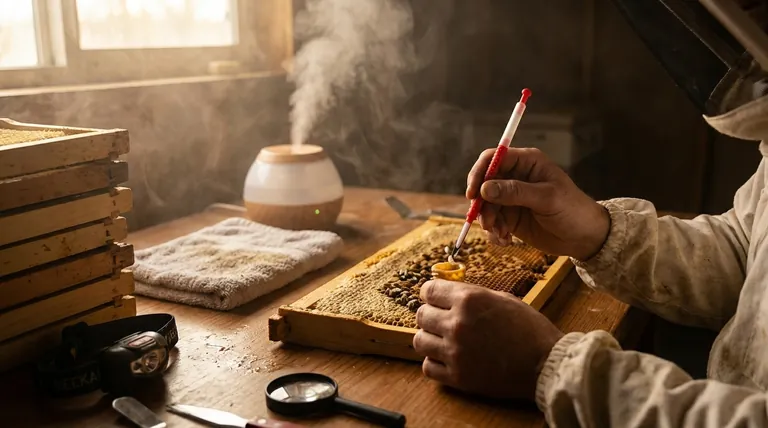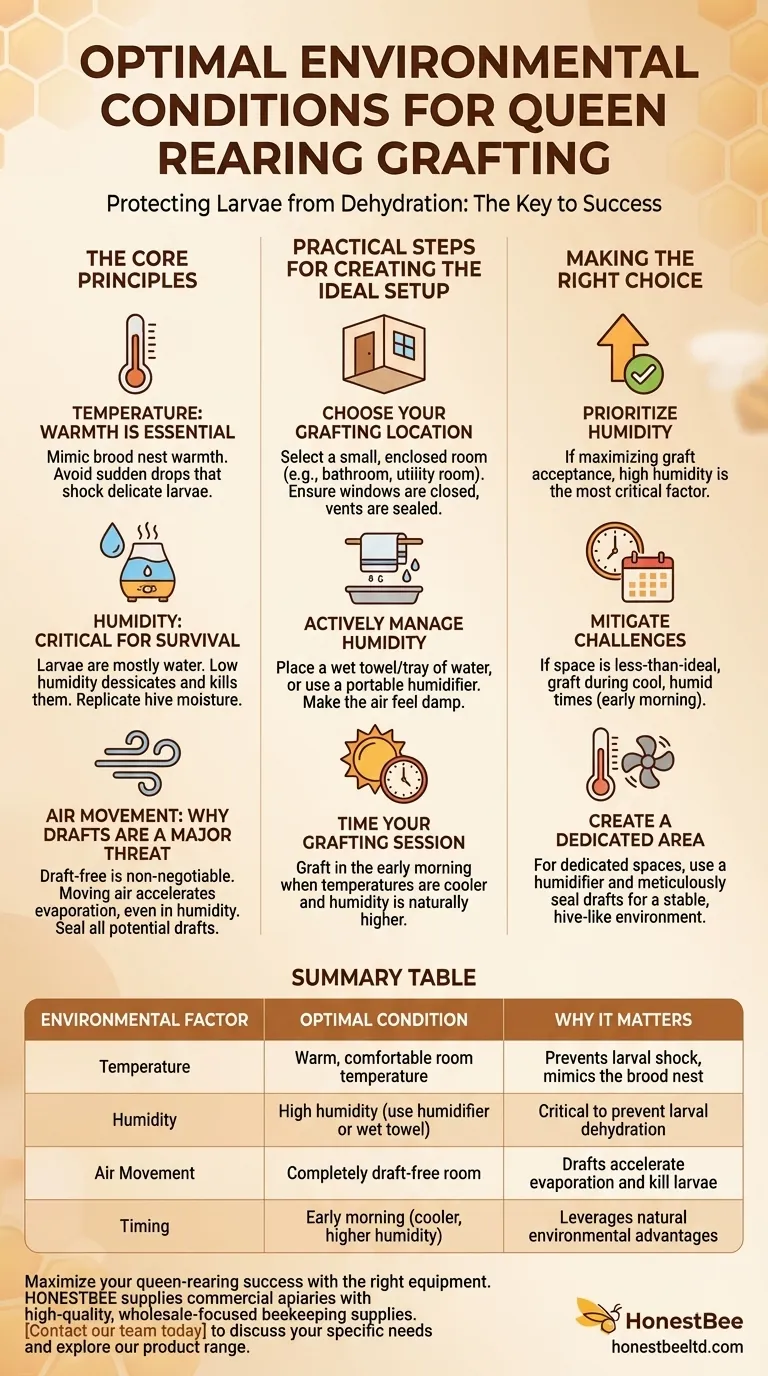For successful queen rearing, the optimal environmental conditions for grafting are designed to protect the larvae from their single greatest enemy: dehydration. The ideal setting is a warm, draft-free room with high humidity that mimics the stable environment inside a beehive.
Grafting is a race against time where the primary challenge is preventing the delicate, moisture-rich larvae from drying out. Your success depends entirely on creating a stable, humid, and warm environment that minimizes this environmental shock.

The Core Principles of the Grafting Environment
To understand the "how," we must first focus on the "why." Every recommendation is centered on protecting the incredibly fragile state of a newly hatched larva once it is removed from the protection of its cell.
Temperature: Warmth is Essential
Larvae are accustomed to the consistent warmth of the brood nest, which is tightly regulated by the colony. Grafting in a cold room can shock the larvae, reducing their viability and acceptance rate.
Aim for a comfortable, warm room temperature. The goal is to avoid any sudden temperature drops that could stress the delicate organisms.
Humidity: The Critical Factor for Survival
This is the most crucial element. Larvae are composed mostly of water and have no ability to protect themselves from moisture loss. Low humidity will desiccate and kill them in minutes.
The air in the brood nest is very humid. Your grafting space must replicate this as closely as possible to ensure the larvae remain viable until they can be placed into their new cell cups and returned to a hive.
Air Movement: Why Drafts Are a Major Threat
A "draft-free" room is non-negotiable. Even a gentle, imperceptible air current—from an open window, a vent, or a fan in another room—dramatically accelerates evaporation.
Moving air wicks moisture away from the surface of the larvae far more quickly than still air, even if the room is humid. This makes eliminating drafts just as important as managing humidity itself.
Practical Steps for Creating the Ideal Setup
Achieving the right environment doesn't require a laboratory, just mindful preparation.
Choose Your Grafting Location Wisely
Select a small, enclosed room where you can easily control the environment. A bathroom or a utility room often works well.
Ensure all windows are closed and any heating or air conditioning vents are sealed off to prevent forced-air drafts.
Actively Manage Humidity
The simplest way to increase humidity is to place a wet towel or a tray of water in the room shortly before you begin. For more consistent results, a small, portable humidifier is an excellent tool.
The goal is to make the air feel slightly damp and heavy, similar to the inside of a bustling hive.
Time Your Grafting Session Strategically
Nature can be a powerful ally. The references wisely suggest grafting in the very early morning.
During these hours, ambient temperatures are typically cooler (avoiding the risk of overheating) and relative humidity is at its highest point in the day. This gives you a significant natural advantage.
Common Pitfalls to Avoid
Success often comes from avoiding simple mistakes. Be aware of these common environmental traps.
The Danger of "Too Hot"
While warmth is good, "hot" is not. The references warn against grafting in very hot weather for a reason. Excessive heat can damage or even cook the larvae just as surely as dehydration.
If you are sweating, the room is likely too hot. Aim for comfortable warmth, not an oven-like environment.
Overlooking Subtle Airflow
Many beekeepers close the door and windows but forget about the subtle drafts from under a door or through a central air vent. These small air movements are enough to compromise your efforts.
Before you begin, hold a lighter or a piece of thin thread near potential draft sources to see if there is any air movement.
Working Too Slowly
The environment you create is a temporary safe haven, but it is no substitute for the hive. The longer a larva is outside of its cell and away from the care of nurse bees, the lower its chance of survival.
Prepare your workspace and tools in advance so that the grafting process itself is efficient and swift, minimizing the larva's exposure time.
Making the Right Choice for Your Goal
Your approach should be dictated by your commitment to maximizing success.
- If your primary focus is maximizing graft acceptance: Prioritize creating high humidity above all else, as larval dehydration is the most common and unforgiving cause of failure.
- If you are working in a less-than-ideal space: Graft during the coolest, most humid part of the day, such as early morning, to naturally mitigate environmental challenges.
- If you are establishing a dedicated grafting area: Control the environment with a humidifier and by meticulously sealing all drafts to create a consistently stable, hive-like workspace.
By meticulously controlling the grafting environment, you transform queen rearing from a game of chance into a predictable and rewarding practice.
Summary Table:
| Environmental Factor | Optimal Condition | Why It Matters |
|---|---|---|
| Temperature | Warm, comfortable room temperature | Prevents larval shock, mimics the brood nest |
| Humidity | High humidity (use humidifier or wet towel) | Critical to prevent larval dehydration |
| Air Movement | Completely draft-free room | Drafts accelerate evaporation and kill larvae |
| Timing | Early morning (cooler, higher humidity) | Leverages natural environmental advantages |
Maximize your queen-rearing success with the right equipment. HONESTBEE supplies commercial apiaries and beekeeping equipment distributors with high-quality, wholesale-focused beekeeping supplies designed for professional results. Let our expertise help you build a more productive and profitable operation. Contact our team today to discuss your specific needs and explore our product range.
Visual Guide

Related Products
- Plastic Chinese Queen Grafting Tool for Bee Queen Rearing
- Retractable Chinese Queen Rearing Grafting Tools Equipment
- Nicot Queen Rearing Kit for Beekeeping and Grafting in Nicot System
- No Grafting Queen Rearing Kit: System for Royal Jelly Production and Queen Rearing
- Wooden Bee Brush with Triple Row Artificial Fiber for Beekeeping
People Also Ask
- What is the process of shaving the cells for grafting? Improve Queen Rearing Success with This Technique
- What are the key steps in the grafting technique? Master Queen Rearing for a Thriving Apiary
- What are the steps involved in using a queen grafting tool? A Guide to Successful Queen Rearing
- How should the selected brood frame be prepared for grafting? A Step-by-Step Guide to Protect Larval Viability
- What happens if a larva is grafted too late? Avoid Scrub Queens and Failed Rearing



















